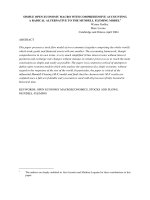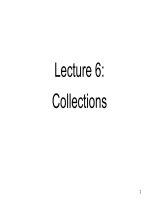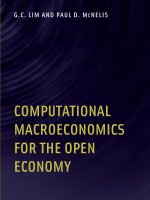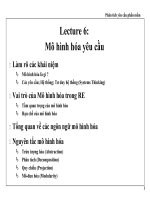Lecture 6 open economy
Bạn đang xem bản rút gọn của tài liệu. Xem và tải ngay bản đầy đủ của tài liệu tại đây (459.89 KB, 59 trang )
LECTURE 10
CHAPTER 3,9,31
OPEN-ECONOMY
MACROECONOMICS
and comparative
advantage and their
application
How everyone can benefit
from trade
LECTURE
OBJECTIVES
Examine the trade
restrictions and the
arguments for and against
them
The International flows
Nominal and Real
OPEN AND CLOSED ECONOMIES
A closed economy: one that does not interact
with other economies in the world.
No exports
No imports
No capital flows.
An open economy: one that interacts freely
with other economies around the world.
INTERDEPENDENCE AND TRADE
ECONOMICS IS THE STUDY OF HOW SOCIETIES
PRODUCE AND DISTRIBUTE GOODS IN AN
ATTEMPT TO SATISFY THE WANTS AND NEEDS
OF ITS MEMBERS.
5
HOW DO WE SATISFY OUR WANTS AND
NEEDS IN A GLOBAL ECONOMY?
Economically self-sufficient.
Specialize and
trade with others,
leading to economic
interdependence.
6
INTERDEPENDENCE AND TRADE
Individuals and nations rely on specialized
production and exchange as a way to
address problems caused by scarcity.
This gives rise to two questions:
Why is interdependence the norm?
What determines production and trade?
7
WHY IS INTERDEPENDENCE THE NORM?
Interdependence occurs because
people are better off when they
specialize and trade with others.
8
WHAT DETERMINES THE
PATTERN OF PRODUCTION AND TRADE?
Patterns of production and trade
are based upon differences in
opportunity costs.
9
A PARABLE FOR THE MODERN
ECONOMY
Imagine . . .
only two goods: potatoes and meat
only two people: a potato farmer and a
cattle rancher
What should each produce?
Why should they trade?
10
THE PRODUCTION OPPORTUNITIES OF THE
FARMER AND THE RANCHER
Farmer
Rancher
Hours Needed to Make 1 lb. of:
Meat
Potatoes
20 hours/lb
10 hours/lb
1 hours/lb
8 hours/lb.
Amount Produced in 40 Hours
Meat
Potatoes
2 lbs.
4 lbs.
40 lbs.
5 lbs.
11
SELF-SUFFICIENCY
By ignoring each other:
Each consumes what they each produce.
The production possibilities frontier is also the
consumption possibilities frontier.
Without trade, economic gains are diminished.
12
PRODUCTION POSSIBILITIES FRONTIERS
Meat
(pounds)
(a) The Farmer’s
Production Possibilities
Frontier
2
1
0
A
2
4
Potatoes
(pounds) 13
PRODUCTION POSSIBILITIES FRONTIERS
Meat
(pounds)
40
(b) The Rancher’s
Production Possibilities
Frontier
20
B
0
5
Potatoes
(pounds)
THE FARMER AND THE RANCHER
SPECIALIZE AND TRADE
Each would be better off if they specialized in
producing the product they are more suited to
produce, and then trade with each other.
The farmer should produce potatoes.
The rancher should produce meat.
15
THE GAINS FROM TRADE
A SUMMARY
Farmer
Rancher
The Outcome
Without Trade:
What They Produce
and Consume
1 lb meat (A)
2 lbs potatoes
20 lbs meat (B)
2.5 lbs potatoes
16
THE GAINS FROM TRADE
A SUMMARY
Farmer
Rancher
The Outcome
With Trade:
What They
Produce
0 lbs meat
4 lbs potatoes
24 lbs meat
2 lbs potatoes
What They
Trade
Gets 3 lbs meat
for 1 lb potatoes
Gives 3 lbs meat
for 1 lb potatoes
What They
Consume
3 lbs meat (A*)
3 lbs potatoes
21 lbs meat (B*)
3 lbs potatoes
17
TRADE & EXPANSION OF THE SET
OF CONSUMPTION POSSIBILITIES
Meat
(pounds)
(a) How Trade Increases
the Farmer’s
Consumption
Farmer’s
consumptio
n with trade
A*
3
Farmer’s
consumptio
n without
trade
2
1
0
A
2
3
4
Potatoes
(pounds) 18
Meat
(pounds)
40
21
20
TRADE & EXPANSION OF THE SET
OF CONSUMPTION POSSIBILITIES
B*
(b) How Trade Increases
The Rancher’s
Consumption
Rancher’s
consumptio
n with trade
B
Rancher’s
consumptio
n without
trade
0
2.5 3
5
Potatoes
(pounds) 19
THE GAINS FROM TRADE
A SUMMARY
Farmer
Rancher
The Gains
From Trade:
The Increase in
Consumption
2 lbs meat (A*- A)
1 lb potatoes
1 lb meat (B*- B)
1/2 lb potatoes
20
DIFFERENCES IN
COSTS OF PRODUCTION
Differences in the costs of production
determine:
Who should produce what?
How much should be traded for each product?
Who can produce potatoes at a lower cost - the farmer
or the rancher?
21
DIFFERENCES IN
COSTS OF PRODUCTION
Two ways to measure differences in costs
of production:
The number of hours required to
produce a unit of output. (for
example, one pound of potatoes)
The opportunity cost of sacrificing
one good for another.
22
ABSOLUTE ADVANTAGE
Comparing productivity
A smaller quantity of inputs to
produce a good to have an
absolute advantage in producing
that good.
23
COMPARATIVE ADVANTAGE
Comparing
opportunity cost.
opportunity cost of producing a good to
have a comparative advantage in producing that
good.
Smaller
24
SPECIALIZATION AND TRADE
Who
has the absolute advantage?
The farmer or the rancher?
Who
has the comparative
advantage?
The farmer or the rancher?
25









